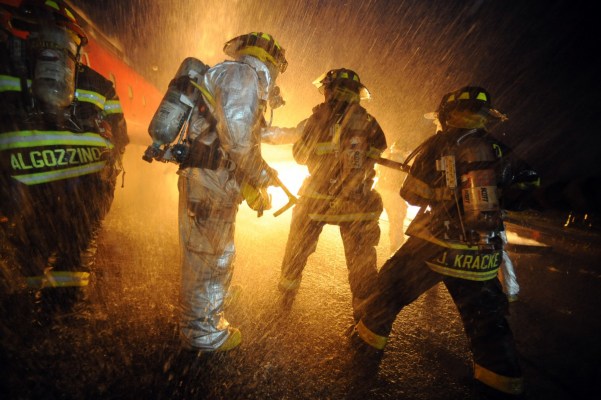In our lives, there will be moments when mere seconds can make the difference between life and death. A fire starts in a home and quickly starts to spread while the occupants are asleep upstairs. A kidnapper grabs a person on the street and begins to drive away. A diner at a restaurant starts choking on their food and enters cardiac arrest.
Too often though, 911 services fail to help, plagued by an infrastructure that can’t handle cell phone location data and that can repeatedly drop emergency calls. That’s where RapidSOS comes in. The two-year-old Boston-based startup is trying to radically improve the emergency call experience – and perhaps save lives in the process.
The 411 On 911
It’s hard to plan for emergencies, which is why we have 911 phone services handy. The system was developed by AT&T in the late 1960s to centralize access to public safety services such as fire, police, and medical through one simple and easy-to-remember number. Given AT&T’s monopoly then, it developed a system compatible with its network of landline phones.
Unfortunately, telecom technology has grown far more complex than when our 911 infrastructure was first deployed. The rise of mobile phones has posed a massive challenge to the 911 dispatch system, since physical location can no longer be derived from the network topology of the landline PSTN network.
Since most 911 calls today are from mobile phones, location data that could be crucial for saving a life or finding a kidnap victim is often unavailable to the emergency operator. In one test in Texas, for example, two-thirds of calls lacked such data.
The problems don’t end there. Due to peculiarities with the 911 system, calls may not even be routed to those who can most help. In Oakland, 911 calls from a cell phone will end up in Vallejo, so the city recommends storing a special city emergency number. Even worse, poor infrastructure may result in dropped calls or long waiting periods – exactly what can’t happen when a caller needs help.
RapidSOS To The Rescue
RapidSOS intends to transform this status quo through a multi-product offering for consumers and institutions that it hopes will dramatically improve emergency services and the performance of first responders.
For consumers, the company has an app that allows users to immediately connect with emergency services no matter where they are through “one touch.” It even works internationally, where “911” isn’t usually the number for emergency services.
That one touch will immediately send location data to 911, but also includes data on medical conditions that a user can pre-populate into the app. Thus, if you have a medical emergency and press the button, it will automatically send potential allergies and blood type info to first responders to help them properly handle your conditions. This data is compatible with all U.S. dispatch centers, although international compatibility for data transfer is not yet fully ready.
For institutions like universities and corporate campuses, RapidSOS offers a product it calls GeoAlert that allows public safety officers to send out mass alerts to precisely the people they need to go to, reducing confusion in an emergency. Today, such alerts are often broadcasted without regard to a user’s location, which can greatly increase the risk of misunderstanding police instructions.
Finally, the company also has a product for emergency call centers called Next Generation 911, which allows operators not only to receive inbound calls, but to take advantage of the photo, video, and microphone capabilities of smartphones. Compared to a simple voice call, that greater context can provide an operator with the information needed to properly direct first responders.
Obviously, these products work best in concert with each other, but they are designed so that each may exist independently of the others. The startup has been careful to build a platform that is entirely compatible with the existing 911 infrastructure, lowering the cost of adoption.
A Long Journey
Michael Martin, a co-founder and CEO of the startup, said that many of the founding members of the team came together because of their own personal experiences with emergencies. “People have rallied around to change and address this challenge. They have taken pay cuts to be part of a meaningful effort here,” he said. The team is a prototypical mix of Harvard business students and MIT nuclear engineers, currently numbering around 20.
Since starting the company two years ago, RapidSOS is now deployed in 44 dispatch centers in North Central Texas as a case study of its 911 platform, and its institutional product is currently being beta-tested by 25 companies and universities.
The consumer product is free for users, but the startup charges institutions a fee for its GeoAlert product. Longer term, Martin expects that the company’s data around emergencies will allow it to offer a predictive analytics platform that might be of interest to Wall Street investment funds and insurance companies.
Interestingly, the startup has not previously raised venture capital, but has instead subsisted on dollars won from startup competitions, which currently amounts to around $500,000. Last month, the team won $70,000 from the President’s Challenge at Harvard’s iLab and $50,000 from Harvard Business School’s New Venture Competition – all in the span of 24 hours.
In addition, the company held a successful Kickstarter fundraise, where it raised $60,123 for its one-touch emergency app. It is currently raising a seed round Martin hopes will propel the startup’s fully public launch.
There are often no second tries when seconds matter. Emergencies are one of the few times when every piece of technology really just has to work. RapidSOS hopes to increase the reliability of our 911 infrastructure, creating a product we hope we never have to use.
